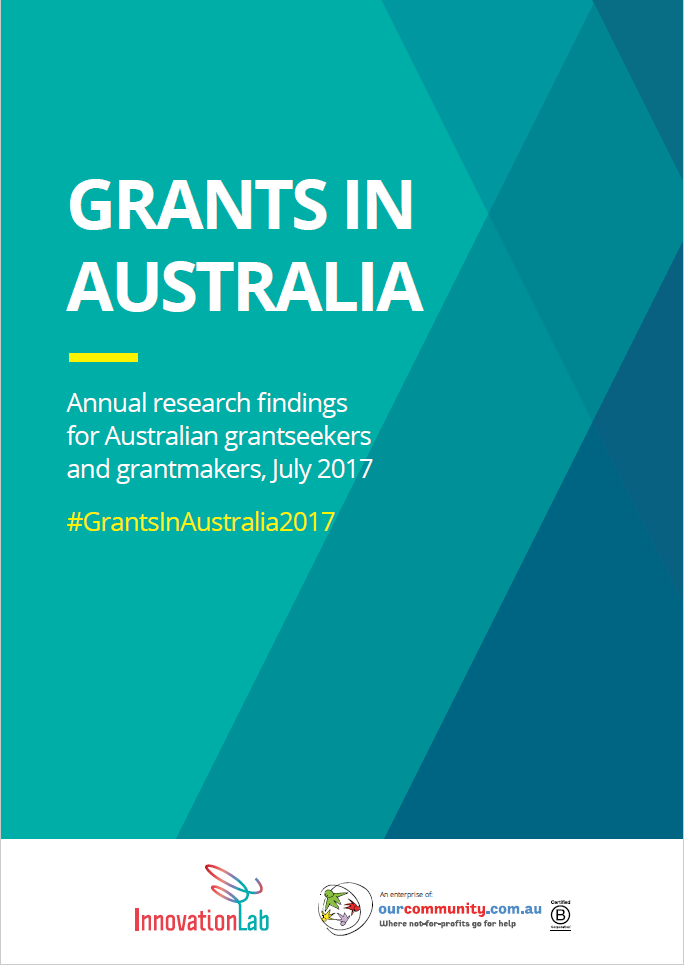Grants in Australia Survey 2017: The quest for perfection continues
By Kathy Richardson, Our Community Executive Director and Chaos Controller
Posted: July 28, 2017

If you're a university researcher, a business looking to ramp up, or any one of Australia's 600,000 not-for-profit organisations, you can't avoid the world of grants.
Around $56 billion is given out in grants across Australia every year. They're dispensed by local councils, state and federal government departments and agencies, by family foundations, community foundations, and corporate foundations. Each funder is looking for a different outcome, but few to none have no expectations about outcomes - grants aren't gifts; they come with strings attached .
Good outcomes are not guaranteed, however, and countless auditors' reports have shown that many millions of dollars worth of grants have been wasted on projects that did not work or whose lessons were not heeded. Common problems include poor program design, inadequate technical and administrative systems, and too much outside interference in the selection process.
That's not acceptable. As we point out in our Grantmaking Manifesto, every grant dollar should produce the maximum benefit for Australian society. Every grant should be both efficient (conducted at the minimum cost and in the minimum time) and effective (producing socially and/or economically valuable outcomes). Every grant should be based on a coherent and plausible rationale. Every grant should be awarded on the basis of clear, transparent, and publicly accessible criteria. Every grant should be an improvement on the last grant.
Since 2006, Our Community has set out to find out how this mass movement of funds can be better managed by speaking to those who know the problems best - grantseekers and grant recipients.
The Grants in Australia study is the biggest research program of its kind.
In 2017 we set our data scientist loose on the 1200 responses from the latest survey, as well as data from all previous years. The result is a report that digs deeper and offers more insights into grantmaking in Australia than ever before.
We've pulled all of this information into a comprehensive report, as well as distilling the lessons for grantmakers and grantseekers into two practical Action Sheets. We've also produced a series of benchmarking tool to allow not-for-profit organisations to compare their grantseeking activities against organisations of the same size, or from the same sector.
All of this is available at www.ourcommunity.com.au/grants2017.
What did we learn?
- Data science + subject matter expertise +
data communication skills = powerful insights
This project employed a multi-disciplinary team comprising a data scientist, two experienced journalists, a graphic designer, and grants subject-matter experts. We learned that this is a powerful combination for allowing the creation, distillation, and communication of data. - Interesting is not the same as useful
This year we pushed ourselves to go beyond pushing out a report. Instead, we committed to finding ways to use the data to produce practical tools that grantmakers and grantseekers could actually use to improve their work. As a result, this year we produce Action Sheets for grantmakers and grantseekers, as well as a benchmarking tool for grantseekers. - You never get it right (but you need to keep
aiming for perfection)
This is the ninth time we've run the Grants in Austalia survey and despite the fact we review and refine the survey each year, we still haven't got it right. Questions and frustrations arising during the analysis phase have been noted to feed into the design of next year's survey. Some examples include:- Asking for whole numbers, not a number range, wherever possible - it produces more malleable results
- We need to be super-precise in our language so we can ensure reliably consistent responses
- We need to remove some questions, either because the insights we seek are now available from other sources (via the SmartyGrants platform or the ACNC annual information statement, for example), or because they've outgrown their usefulness
- We need to add some new questions - the more we know, the more we want to know. For example, this year we uncovered some alarming data about how many applications are being started but not completed. Next year we want to try to find out more about why they're not completed.
Onward!
